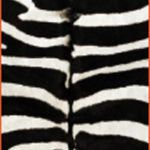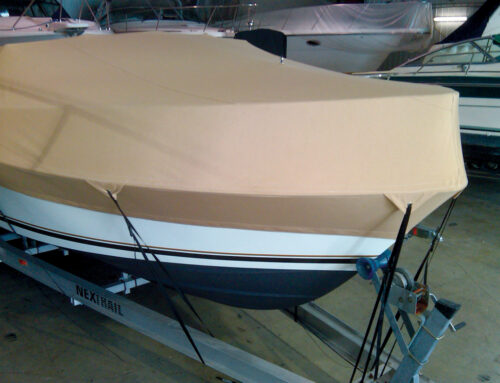Exotic hides offer high-end options
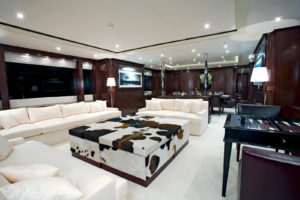
An arrangement of hair-on leather trunks makes a stunning centerpiece in a lounge area of the 147-foot motor yacht “Africa,” made by Sunrise Yachts. Interior design by Franck Darnet. Hair-on leather can evoke an exotic setting or the American West, depending upon the overall “look” of an interior. Photo: M.Carlin, LuxMedia Group/Sunrise Yachts.
While exotic hides are more likely to be found in the salon of a megayacht than below deck on your average pleasure craft, they are no longer the exclusive province of the rich. Prices of some exotic hides have dropped in recent years due to increased production. Also, some faux-exotics and lower-cost options like inlays are available. Even if you’ve never had a client request a crocodile-accented headboard, you never know when a well-heeled boat owner is going to walk into your shop and ask for “something different.”
When that day comes, you’re going to want to know what options are available, how to source exotic hides, how to use them, and how to treat them so they resist stains and rot. Your expertise will make for happy high-end customers and positive word of mouth.
If you are accustomed to working with marine vinyls, exotic hides may seem intimidating from both a technical and a logistical standpoint. First of all, exotics are expensive. Second, assembling a network of reputable suppliers can be tricky. Third, some exotic hides, like stingray, have attributes that can drive new-to-exotics fabricators crazy.
Here is what you need to know about working with exotic hides, from which hides stand up best to marine environments—hint: think creatures that are at home in the water—to how to work with a popular hide that is notorious for breaking needles.
The real deal
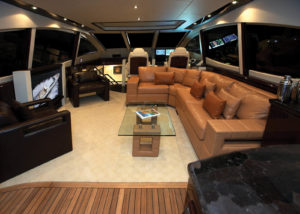
A latte-brown ostrich-leather sectional sofa adds exotic luxury to the salon of the Lazzara LSX75 express cruiser. Ostrich is one of the more delicate exotic hides. A faux-ostrich choice like Majilite Baby Ostrich is a hardy substitute. Photo: Lazzara Yachts.
While customers who crave the look and status of exotic upholstery can choose from a menagerie of available hides, including zebra, elephant, kangaroo and hippo, some hides are much better suited to marine applications.
“I would say stingray, shark and eel since they come from the water,” says Jeremiah Kapp of Rojé Leather. “Stingray handles water really well. But any of these exotic skins, as long as you put a heavy lacquer on it that will maintain it.” Other water-loving creatures with interesting hides include salmon, crocodile, alligator and hippo.
“Hippo is the only skin that I buy that is naturally suede,” says Dan Ballard, owner of Bitchn Stitchn Inc. in Lakewood, Colo. “Not a lot of hair on them.” Hippo hides typically come festooned with scars.
The standard stingray finish is bumpy, almost pebbled, but it can be sanded down to a medium grain or a smooth, polished finish. Polished stingray is often called “shagreen” and costs up to a third more than unpolished stingray. You can get stingray in almost any color and pattern, including python.
When it comes to status-symbol skins, Henry Slaughter, owner of exotic hides supplier Ostrich Market and Alligator Jake’s (maker of finished products) in Melbourne, Fla., asserts that alligator is “the number-one skin in the world, always has been and always will be.” Indeed, alligator’s kissing cousin, crocodile, can be seen covering the couches and accenting the staterooms of many contemporary luxury yachts.
Another, less-expensive interior upholstery option is cowhide leather embossed to resemble exotics. Such leather is available in snakeskin, stingray, ostrich, alligator and crocodile finishes, among others. There are also dozens of faux-exotic vinyls rated for hospitality use, mimicking everything from steer (such as Infiniss Hair-On Hide Steer) to dinosaur (such as Nuvtex Dino). Majilite Baby Ostrich is one of the very few exotic-look-a-like marine vinyls. Majilite offers embossing in exotic patterns like gator, crocodile, snakeskin and tagis (lizard).
Dremels and dinosaur hide
Before you start working with an exotic hide destined for a marine application, you’re going to want to treat it.
“Some exotic skins are so vulnerable that even one drop of wine or coffee will result in a big spot,” explains “Doc” Bailey, owner of Doc Bailey’s Leather Care Products. “They are absolutely more vulnerable to a marine environment. It’s the salt in the air, the moisture, the humidity.” He says people often regret investing in exotic-hide products because of that vulnerability. But there are solutions.
His company makes a product called Leather Clear that is designed to protect exotic-skin motorcycle seats from the elements. It contains a light detergent to clean the skin, lanolin (derived from sheep’s wool) to soften and condition it, and a wax that “does not change the feel or patina at all, yet you spill your coffee and it beads off.”
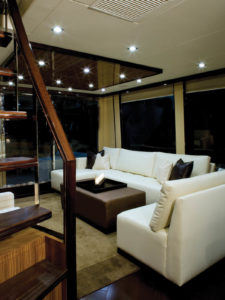
Majilite-covered ceiling panels, faux-leather couch upholstery and a mock-croc cushion (Valtekz Crocodile in Truffle) create an atmosphere that invites relaxation aboard the Lazzara Breeze 76 motor cruiser. Sharp contrasts in color and texture add visual interest to any interior. Photo: Lazzara Yachts.
Such protective properties would be equally useful in a yacht environment, Bailey points out. In fact, in 2010, he worked with a Monte-Carlo-based upholstery company that makes seats for “sky’s-the-limit-type yachts.” Custom treatments can be developed if you work with exotic hides often.
After treating the hide, you will need to know how to work with it. Most exotic hides are straightforward to work with and maintain. Stingray and caiman are the fussy exceptions. Stingray is a notorious needle-breaker. “They’ve got this crusty little finish on the outside,” says Johann Merkhofer of Coachtrim LLC in Danbury, Conn. “It’s tough on the sewing machine needles.”
“Sewing with stingray can be a real challenge,” Kapp confirms. “A lot of people think they should use a diamond-tip needle when in actuality you should use a titanium needle.” His other recommendation is to Dremel down the top surface of the skin, especially in areas that are bumpy, to create a stitching groove so that “your lines will actually go straight.”
Caiman hide (from a South American crocodilian that resembles alligator) can also be hard to sew, particularly if you purchase a large hide. As the animal gets bigger, the skin “tends to be more primitive in the sense that it becomes like dinosaur skin,” Kapp says. “It’s almost impossible to get anything over 17 inches where you can still sew through it.” Stick to smaller caiman skins.
Maintaining exotic hides is as simple as maintaining leather. Bailey strongly recommends using a lanolin-based conditioner. “It’s important not to have a conditioning oil that is animal-fat-based because it rots.” Also, advise your customer to condition often, as exotic hides are thinner than leather and thus have less oil in them.
Supply and demand
In 2009, U.S. Customs and the U.S. Fish and Wildlife Service seized $100,000 worth of endangered-animal hides and tusks from a 120-foot motor yacht called Mystére that had been brought into Port Everglades, Fla., via cargo ship. The illegal decorations included lion, tiger, jaguar and leopard skins. The yacht’s owner, New-York-dwelling billionaire Tamir Sapir, forfeited the items and paid $150,000 in fines.
Don’t set your customer up to encounter law enforcement difficulties. When sourcing exotic hides, look for well-established suppliers that state their compliance with CITES (Convention on International Trade in Endangered Species of Wild Flora and Fauna, www.cites.org) regulations to ensure you are in the clear legally and to help ensure species conservation.
Exotic hide suppliers tend to specialize in a species or a cluster of species. Merkhofer has developed relationships with other upholstery shops across the country. If he doesn’t know where to source a particular exotic hide, he can call around and get advice. Don’t be afraid to follow his lead.
Start off on the right foot with an exotic-hide supplier by avoiding this pet peeve: requesting a swatch of every color in every species.
“Have your desired color range narrowed down,” Kapp says. He points out that no supplier wants to cut into an exotic hide worth several hundred dollars for the sake of a tiny swatch. He also advises waiting until you have a confirmed project with a deposit before you call and ask a lot of questions. You will get more accurate price information that way. Prices and color availability fluctuate based on demand.
If you anticipate any market for exotic-hide marine upholstery in your area, Kapp suggests investing in full hides, perhaps one of each marine-friendly species, so you and your potential customers can get the full visual and tactile effect.
Shelby Gonzalez is a freelance writer who works with trade and consumer publications.
Some Wild Options:
-
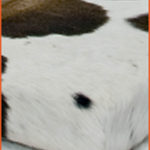
- Cowhide: Hair-on cowhide lends a frontier element to upholstery work. When working with hair-on hide, positioning the hide so the “grain” of the hair lays the way you want can be a challenge. Photo: M. Carlin, Luxe Media Group/Sunrise Yachts.
-
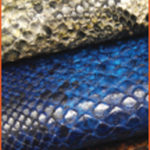
- Rattlesnake: The pattern of Valtekz Rattlesnake repeats every 6 inches horizontally and 11 inches vertically. Photo: Valtekz Composite Fabrics.
-
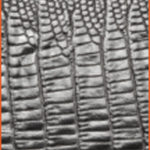
- Alligator & Crocodile: Alligator and crocodile hides are most often used in accessories and motorcycle seats. Using them in a large application, like a headboard, will produce a particularly eye-catching piece.
-

- Stingray: Stingray is available in dozen of colors and patterns, including python, zebra and metallics.
-
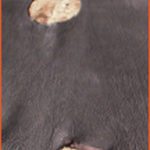
- Shark: Shark leather prior to use. The hides of water-going creatures like crocodile, stingray and shark are naturally more resistant than other leathers to the high humidity of a marine environment, but still should be treated. Photo: Roje Leather.
-
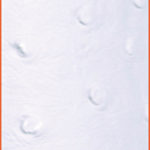
- Ostrich: Ostrich hide, whether genuine or faux, like Valtekz Ostrich, sports a distinctive stippled pattern. Photo: Valtekz Composite Fabrics.
-
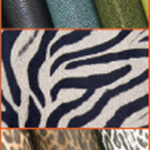
- Faux: One advantage of using faux hide like Valtekz Leopard or Valtekz Shagreen is that you can cover a substantial area, such as a wall or a piece of furniture, without having to painstakingly assemble a patchwork of hides. Photo: Valtekz Composite Fabrics.
 TEXTILES.ORG
TEXTILES.ORG 


